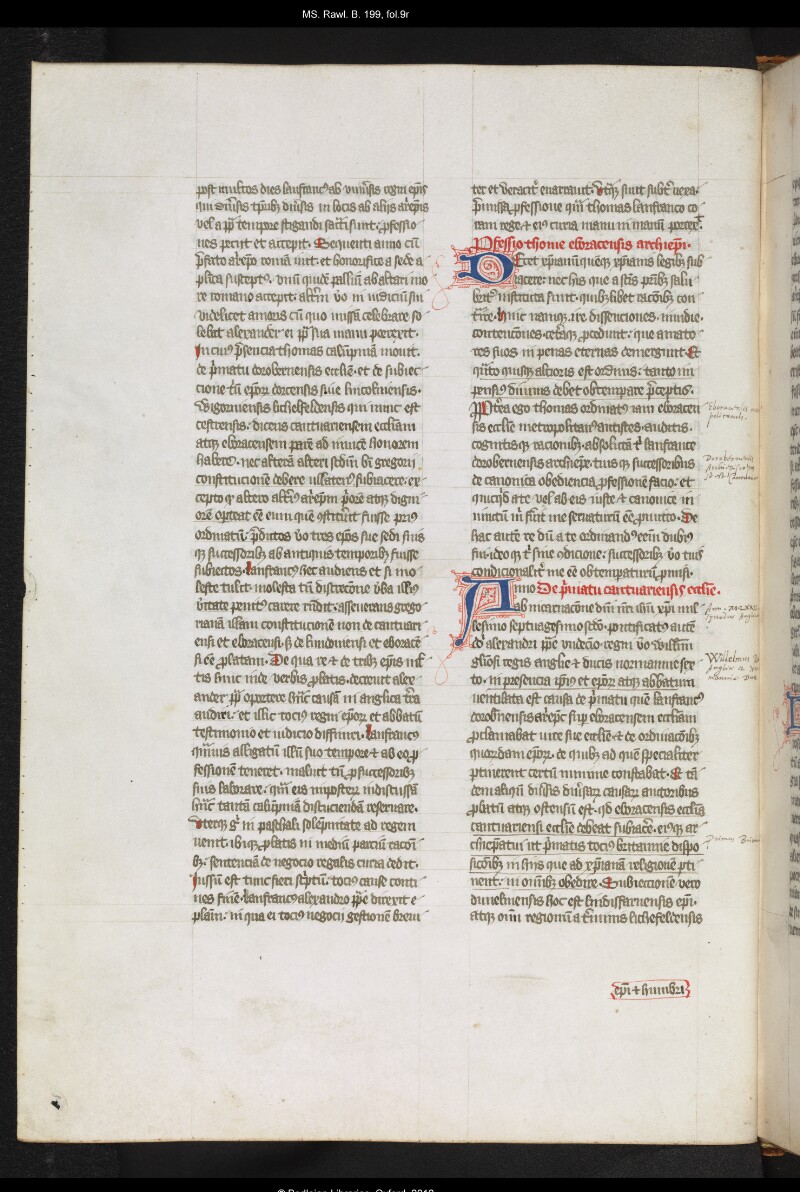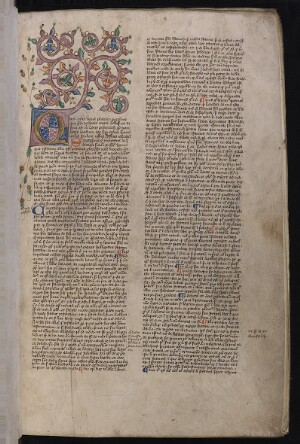The Minster Bequest
Nigel Ramsay (University of Exeter)
The number and the sheer range of Neuton's books show him to have been bookish to an unusually high level. He could afford them because he had reached the top in two worlds—the academic and the ecclesiastical. In the fifteenth century, for all the efforts that had been made to raise the clergy's educational standards, there was still a tendency for even cathedral canons—and especially the group that each cathedral tended to have, of residentiaries who were the props of continuity and regularity in its organisation—to be non-academics. That is to say, men whose lives were dominated by what was experienced within the cathedral close, and not by the wider mental outlooks that the universities fostered. Neuton was emphatically not one of these.

Fig. 1 - Fol. 8v of Neuton's copy of the Gesta pontificum Anglorum, which contains some of Malmesbury's chapters on the Canterbury-York Dispute. Underlining and marginal notes have been added by a sixteenth-century (?) hand. (Reference: Oxford, Bodleian Library, MS Rawlinson B. 199.) Photograph: © The Bodleian Library, University of Oxford.
Neuton was fairly exceptional in holding such senior posts in each world, being Treasurer of York Minster for twenty-one years and Master of the Cambridge college, Peterhouse, for fifteen. For four years he held the two offices in tandem. But even this did not mark the limits of his career. He must have been highly proficient in both canon and civil law: he was a Doctor of Civil Law, and he was sufficiently experienced in canon law to have been appointed first the commissary general of the bishop of Ely and then, for many years, the official of Ely and subsequently the official of York. He was also for a year or so the vicar-general of the archbishop of York, Richard Scrope. He was thus extremely well-versed in the practical workings of the canon law and of the general administration of the Church—the field with which much of the canon law was concerned. In addition to all this, he went on at least one diplomatic mission for the Crown, to Picardy, to treat for peace with the French. That was a typical activity for a senior civil lawyer, but nevertheless yet another piece of business to fit into a crowded working life.
There are a few pointers as to what he thought about his books. His direction in his will that his nephews were to have the right to use 35 of his books of canon and civil law—presumably for as long as they wanted—shows that these were books that he considered particularly useful for those studying the law. More generally, the directions in his will about the disposal of the rest of his library show how he felt about those books in terms of their aptness for different legatees. It seems clear that he had considered very carefully which books would most appropriately go to which person or institution. For the Minster, he is explicit in the opening words of his will: he is leaving it books that will help in the making of a library ('in subsidium et relevamen librarie faciendum'). In other words, he was helping form a cornerstone of a collection (1).
The Minster bequest was carefully selected. It is a mixture of the basic, the well-known and the uncommon or even rare, beginning with a three-volume Bible and a great book of biblical concordances (probably the Concordia maior, the so-called 'third concordance'), the glossed Pauline Epistles, and separate books with glossed copies of Genesis and Exodus, Wisdom and Ecclesiasticus, and the Twelve Prophets. There are also the basic patristic works: St John Chrysostom's De compunctione cordis, St Gregory the Great's Moralia in Iob and Homiliae in Ezechielem as well as his Dialogi, De cura pastorali and Homiliae in Canticum Canticorum, and St Augustine's De Trinitate and Sermones de verbis domini et apostoli as well as further, unspecified works by Augustine. There is a book containing four separate works, the second of which is a group of treatises by Alcuin, whom he notes as 'once a canon of the church of York'. Of the twelfth- and thirteenth-century scholastics, there are such works as a part of the Summa Theologica of St Thomas Aquinas, the Sentences of Peter Lombard, William of Auvergne's De fide et legibus, and the Historia Scholastica of Petrus Comestor, as well as unspecified works by St Anselm and St Bernard of Clairvaux. These were indeed the basic building blocks of any later medieval library.
There are a few books that would have been of value in pastoral and preaching activities: the Sermones dominicales of Robert Holcot, the Catholicon of John of Genoa, and what he describes simply as 'a beautiful book of assorted sermons' ('librum pulcrum de diversis sermonibus'). But there are also books that were less clearly requisite to an ecclesiastic's training. There are historical works like Bede's Ecclesiastical History, Alfred of Beverley's History of the Kings of Britain and William of Malmesbury's Gesta Pontificum Anglorum (History of the English Bishops) (Fig. 1). There are works of spiritual guidance, such as unspecified ones by Richard Rolle and Walter Hilton, the Meditations or Stimulus peccatoris of the Cistercian monk William Rymington, and Hugh of St Victor's De institutione noviciorum, an introduction to the monastic life. There are a few books of civil and canon law: Bartolus on the New Digest (almost certainly now MS XVI P. 6 in the Minster Library), Cino on the Codex (surely now MS XVI P. 8 in the Minster Library, Fig. 2) and Henry Bohic on the Decretals (2). And last, but emphatically not least, there is a copy of Petrarch's De remediiis utriusque fortunae—a work of sufficient rarity in England as to raise the question of whether Neuton might have acquired it when abroad. Had he perhaps gone to an Italian university at some point, as so many up-and-coming civil lawyers did?
Neuton's bequest to the Minster Library totals some 35 volumes. He left a further 35 as a lifetime bequest to any son of his brother Thomas who, in due course, might wish to study civil and canon law. In the meantime, these books were to remain in a locked chest in the Minster vestry. It seems likely that no such nephew did wish to follow in John Neuton's footsteps, since at least four of these books seem to be identifiable in the Minster library today. They are a fine collection of the best-known works in the field, especially of canon law (3). There are basic canon law texts, such as the Decretum of Gratian, the Decretals of Gregory IX and the Liber Sextus of the Decretals; there are the classic commentaries, for instance of Guido de Baysio ('Archidiaconus') on the Decretum; of John Andreae on the Decretals; of Hostiensis (Henry de Segusio) on the Decretals; of John of Lignano on the Decretals; and John Andreae, Jesselin de Cassagnes and William of Mont Lauzun on the Clementines. There are also two of the classics of canon law: the Repertorium (or Breviarium) of William Durandus; and the Tabula or Margarita Decreti of Martin of Troppau.
Neuton's list has at this point already mentioned a copy of the Bolognese glossator Azo's Brocardia and one of the Ordo iudiciarius of Tancred of Bologna, but a little later in his will he moves on to list the mainstream civil law texts and commentaries. A complete set of the Digest is followed by works by Bartolus, Cino, Dinus de Mugello and Petrus de Bellapertica. With these on his shelves (and hopefully at his fingertips), any nephew would have been well set up indeed. But the presence on the Minster shelves today of such works as Bartolus's commentary on the Codex (MS XVI P. 5) strongly suggests that in fact all these books too were sooner or later absorbed into the Minster's library, exactly as Neuton had directed in his will should be the case with this portion of his remarkable library.
(1) A full edition of the parts of Neuton's will that relate to the Minster library is to be published in a volume on The Secular Cathedrals of England and Wales, ed. by N. Ramsay and J. Willoughby, in the Corpus of British Medieval Library Catalogues.
(2) Cino on the Codex appears twice: once in the Minster bequest and once amongst the manuscripts in the nephews' chest. Neuton may have owned two copies or mistakenly bequeathed the same copy twice.
(3) For an introductory account of the works of civil and canon law that were in circulation in England at around this date, see N. Ramsay, 'Law', in Cambridge History of the Book in Britain, vol. III, 1100-1400, ed. by R.M. Thomson and N.J. Morgan (Cambridge: Cambridge University Press, 2007), pp. 250-290.
How to cite
Nigel Ramsay, 'The Minster Bequest', in Hanna Vorholt and Peter Young (eds), 1414: John Neuton and the Re-Foundation of York Minster Library, June 2014, https://yml1414.york.ac.uk/
